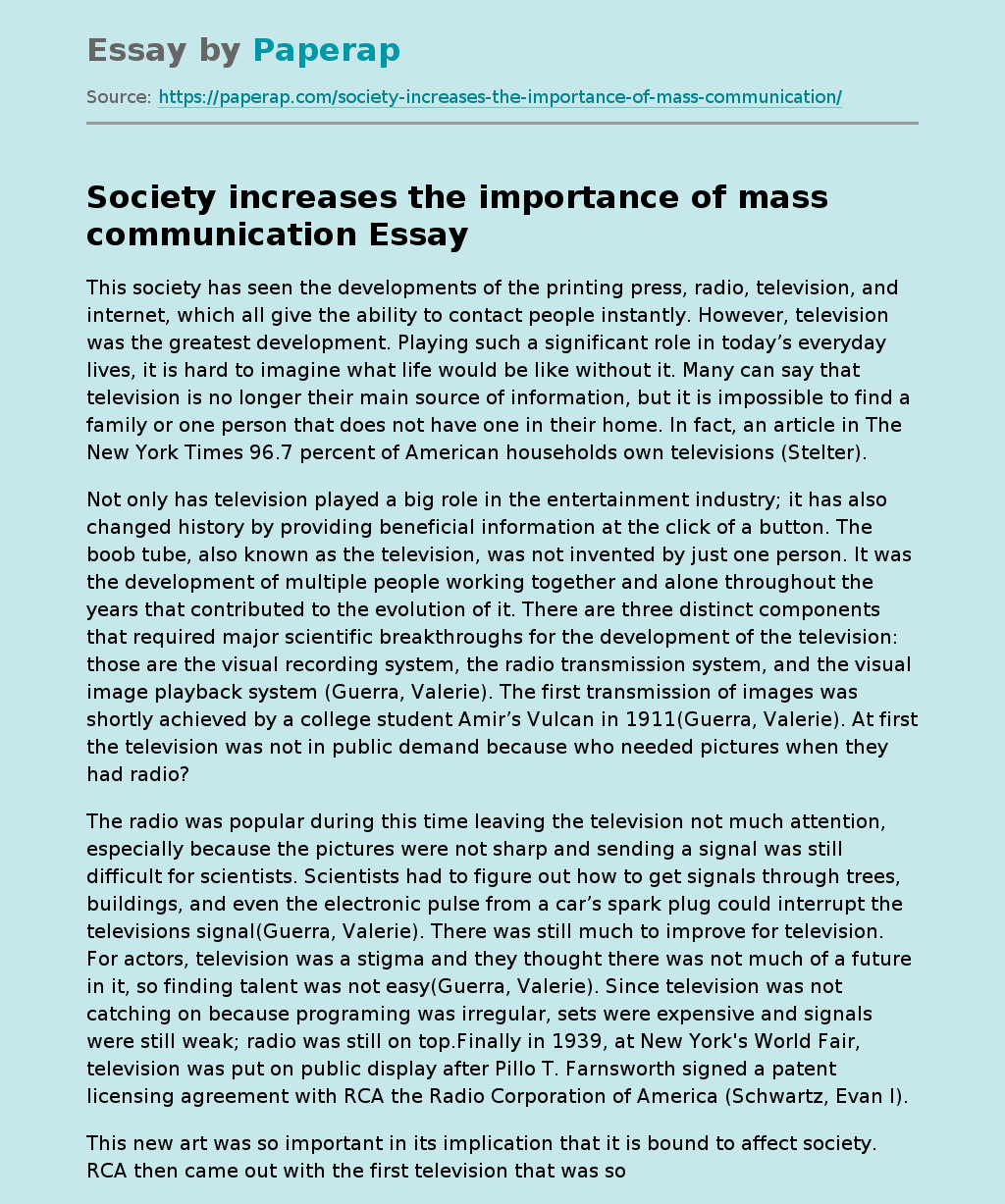Society increases the importance of mass communication
This society has seen the developments of the printing press, radio, television, and internet, which all give the ability to contact people instantly. However, television was the greatest development. Playing such a significant role in today’s everyday lives, it is hard to imagine what life would be like without it. Many can say that television is no longer their main source of information, but it is impossible to find a family or one person that does not have one in their home.
In fact, an article in The New York Times 96.7 percent of American households own televisions (Stelter).
Not only has television played a big role in the entertainment industry; it has also changed history by providing beneficial information at the click of a button. The boob tube, also known as the television, was not invented by just one person. It was the development of multiple people working together and alone throughout the years that contributed to the evolution of it.
There are three distinct components that required major scientific breakthroughs for the development of the television: those are the visual recording system, the radio transmission system, and the visual image playback system (Guerra, Valerie). The first transmission of images was shortly achieved by a college student Amir’s Vulcan in 1911(Guerra, Valerie). At first the television was not in public demand because who needed pictures when they had radio?
The radio was popular during this time leaving the television not much attention, especially because the pictures were not sharp and sending a signal was still difficult for scientists.
Scientists had to figure out how to get signals through trees, buildings, and even the electronic pulse from a car’s spark plug could interrupt the televisions signal(Guerra, Valerie). There was still much to improve for television. For actors, television was a stigma and they thought there was not much of a future in it, so finding talent was not easy(Guerra, Valerie). Since television was not catching on because programing was irregular, sets were expensive and signals were still weak; radio was still on top.Finally in 1939, at New York’s World Fair, television was put on public display after Pillo T. Farnsworth signed a patent licensing agreement with RCA the Radio Corporation of America (Schwartz, Evan I).
This new art was so important in its implication that it is bound to affect society. RCA then came out with the first television that was sold to the public(Schwartz, Evan I). They also announced the first program that was scheduled to air, which was president Franklin D. Roosevelt welcoming everyone to the fair. For two hours a week Americans could now tune into regular broadcasts on NBC. There were only two hundred sets in New York and television was now becoming a reality. Soon after the New York Fair, the first television drama Streets Of New York was broadcast in 1940(The History of The Television documentary).The progress in television methods was slow. Attempts with commercials were fraught with production hazards. For instance, Ford tried to have a 1940 Ford car behind a fishbowl.
They forgot how hot the studio lights were so when they went on the air there was all dead fish because the water rose to boiling point and killed the fish(The History of The Television documentary). Besides the problems broadcasting was emerging as a powerful social network. The technology was improving and at RCA a more efficient camera tube was invented that captured an image with few hot lights(Guerra, Valerie). All of the research and development was costing a fortune and there was not much to show for it. RCA formed an alliance with Alain Dumont, the Dumont Network has superior field operations and RCA had promotions; together they arranged the World Series of 1947(The History of The Television documentary).
Harry Coyle set the path for sports coverage by experimenting with multiply different camera angles. The demand for television sets began to grow but the cost for most Americans was still too high. Earl Monks took apart several different television sets and interchanged parts, he made a striped-down set and sold them for one hundred and seventy dollars (The History of The Television documentary). This caused competitors to lower their prices as well, and by 1949, there were four million television sets in America (Schwartz, Evan I). There were not many shows and the ones that were had bad signals. Actors and actresses were being created overnight. Like one of America’s best-known actresses, Norma Jeane Mortenson who is now known as Marilyn Monroe. Television arose the demand for live broadcasts of events which made many obstacles.
If life was in color why was a television in black and white? This question set many on a mission to develop color television. David Sarnoff at RCA finally developed a new process inside the camera. Through mirrors, the image is broken down into the three primary colors and sent into three different tubes so when the electrons came back they would reflect the color picture(Schwartz, Evan I). Color television was next put on the market in 1954 which led programming to begin to take off(Schwartz, Evan I).
Society increases the importance of mass communication. (2021, Dec 03). Retrieved from https://paperap.com/society-increases-the-importance-of-mass-communication/

